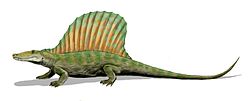This article relies largely or entirely on a single source .(June 2024) |
| Microvaranops Temporal range: Late Permian, | |
|---|---|
| Scientific classification | |
| Domain: | Eukaryota |
| Kingdom: | Animalia |
| Phylum: | Chordata |
| Clade: | Synapsida |
| Family: | † Varanopidae |
| Genus: | † Microvaranops Spindler et al., 2018 |
| Type species | |
| †Microvaranops parentis Spindler et al., 2018 | |
Microvaranops is a Middle Permian synapsid of the family Varanopidae from the Abrahamskraal Formation of South Africa. [1] It includes one species, Microvaranops parentis, which was probably arboreal. A slab containing five specimens of Microvaranops indicates that it gathered or lived in groups.





